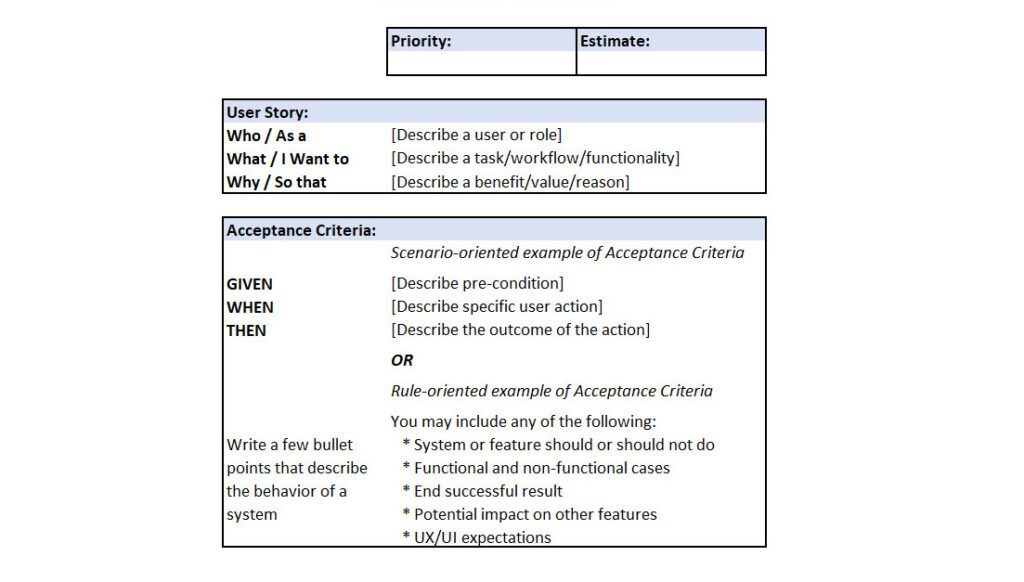Table of Contents
In agile software development, user stories play a critical role in defining the requirements and goals of the end product. A user story is a simple, concise description of a user’s need or goal, which serves as the basis for the development team’s work. Writing effective user stories is essential for ensuring that the development process is focused on the needs of the users and that the end product is of high quality and meets the users’ needs.
However, writing effective user stories can be challenging, as it requires the ability to communicate clearly and concisely, and to identify and prioritize the most important user needs and goals.
In this article, I will explore the key elements of effective user stories and provide practical tips and best practices for writing user stories that are clear, concise, and effective.
Whether you are a product owner, a developer, or a member of a cross-functional team, this article will provide you with the knowledge and tools you need to create user stories that drive successful software development.
What Are User Stories?
A user story is a technique used in software development to capture the needs and requirements of the end user concisely and understandably. It is brief, simple, and written from the perspective of the user, which makes it easy to understand the development team and other stakeholders. A user story typically consists of a sentence or two that describes a specific feature or functionality of the software system that the user needs to accomplish a task or achieve a goal.
Compared to traditional requirements, which are often lengthy and written from a technical perspective, user stories are designed to be more user-centric and focused on the end user’s needs. They are typically shorter and less detailed than traditional requirements, which allows teams to iterate and adapt more quickly based on feedback from stakeholders and end users.
User stories are often written on index cards or sticky notes and are typically organized into a backlog that the development team can work through during the project. By focusing on the needs of the end user, user stories help teams stay focused on delivering value to the customer and ensure that the software system meets the needs of the end users.
User stories are an effective tool for improving communication and collaboration between the development team and other stakeholders, and for ensuring that the software system meets the needs of the end user.
Importance of User Stories
User stories play a crucial role in software development because they help teams stay focused on delivering value to the customer. By capturing the needs and requirements of the end user concisely and understandably, user stories help teams understand what the end user wants and needs from the software system.
One of the key benefits of using user stories is that they help teams prioritize their work based on the needs and goals of the end user. By focusing on delivering value to the customer, teams can ensure that they are working on the most important features and functionality first, which can help reduce waste and improve efficiency.
In addition, user stories help improve communication and collaboration between the development team and other stakeholders, such as business analysts, product owners, and end users. By providing a clear and understandable way to capture and communicate requirements, user stories help ensure that everyone is on the same page and working towards the same goals.
Finally, user stories help teams stay flexible and adaptable by allowing them to iterate and adapt based on feedback from stakeholders and end users. By breaking down requirements into smaller, more manageable pieces, teams can quickly and easily make changes and adjustments to the software system as needed.
How to Write an Effective User Story
To write effective user stories, there are several guidelines and best practices that software development teams can follow.
- It is important to ensure that the user story is clear and concise. This means that it should be written in a simple and easy-to-understand language that is accessible to everyone, including non-technical stakeholders.
- User stories should be focused on the needs of the end user, rather than on technical details or internal processes. This means that user stories should describe what the user wants to achieve, rather than how the software system will achieve it.
- User stories should be specific and measurable. This means that they should be written to allow the team to easily identify when the user story has been completed, such as by defining acceptance criteria.
- User stories should be small and manageable. This means that they should be broken down into small pieces that can be completed in a single sprint or iteration.
- It is important to involve the end user in the user story-writing process. This can help ensure that the user stories accurately reflect the needs and goals of the end user, and can also help improve buy-in and engagement from the end user.
User Story Templates
User story templates are a useful starting point for software development teams to create effective and consistent user stories. These templates can help ensure that user stories are structured clearly and concisely, which can make them easier to understand and implement.
One common user story template is the As a [user], I want [goal], so that [reason] template.
This template helps ensure that user stories are focused on the needs and goals of the end user, rather than on technical details or internal processes. For example, a user story might be As a customer, I want to be able to easily add items to my shopping cart so that I can quickly complete my purchase.
Another popular user story template is the To [goal], as a [user], I need [specific requirement] template.
This template emphasizes the importance of specifying the specific requirements that are needed to achieve the user’s goal. For example, a user story might be To complete my purchase quickly, as a customer, I need to be able to easily see the price and quantity of items in my shopping cart.
Some teams may also use a Who, What, Why template, which breaks down the user story into three distinct parts:
- who the user is,
- what they want to achieve,
- and why they want to achieve it.
This can help ensure that user stories are specific, measurable, and focused on delivering value to the end user.

Estimating Effort
Accurate effort estimates help teams to understand how much work can be completed within a given timeframe and ensure that they are delivering value to the end user.
Here are some tips for estimating effort:
- Break down user stories: User stories should be broken down into smaller, more manageable tasks. This allows teams to estimate the effort required for each task more accurately.
- Use past performance as a guide: Teams can use past performance as a guide when estimating effort. For example, if a similar user story took two days to complete in the past, a similar story can be estimated to take two days in the future.
- Consider complexity: Complexity is a significant factor when estimating effort. More complex user stories may require more effort to complete than simpler ones.
- Involve the team: The entire team should be involved in the effort estimation process. This helps to ensure that all factors are considered and that everyone has a shared understanding of the effort required.
Once effort estimates have been determined, teams can use this information to plan sprints and releases.
For example, if a user story is estimated to take five days to complete, and the team has a two-week sprint, the user story may need to be broken down into smaller tasks to fit within the sprint timeframe.
Incorporating Feedback
Feedback from stakeholders and end users helps to ensure that the user stories accurately reflect the needs and goals of the end users.
Here are some tips for incorporating feedback:
- Solicit feedback early and often: Teams should solicit feedback from stakeholders and end users early in the development process and throughout the development lifecycle. This helps to ensure that the user stories are aligned with the needs of the end users.
- Prioritize feedback: Teams should prioritize feedback based on its impact on the user experience. The feedback that has a significant impact on the end-user experience should be given higher priority.
- Incorporate feedback into user stories: Teams should incorporate feedback directly into user stories. This helps to ensure that the feedback is addressed and that the user stories accurately reflect the needs of the end users.
- Collaborate with stakeholders and end users: It’s important to collaborate with stakeholders and end users when incorporating feedback. This helps to ensure that everyone has a shared understanding of the feedback and how it will be addressed.
- Continuously reassess: User stories should be continuously reassessed and refined based on feedback from stakeholders and end users. This helps to ensure that the user stories remain aligned with the needs of the end users throughout the development process.
Common Mistakes to Avoid
When writing user stories, teams make common mistakes that can impact the quality of the stories and hinder the development process.
Here are some common mistakes to avoid:
- Writing too complex stories: User stories should be simple and easy to understand. Complex stories can be difficult to implement and may require more effort to complete.
- Failing to involve the end user: User stories should be written with the end user in mind. Failing to involve the end user in the development process can result in stories that do not meet the needs of the end user.
- Focusing too much on technical details: User stories should focus on the needs and goals of the end user, not technical details. Teams should avoid writing overly technical stories and instead focus on how the feature or functionality will benefit the end user.
- Failing to prioritize stories: Teams should prioritize user stories based on their impact and value to the end user. Failing to prioritize stories can result in features that do not provide value to the end-user or that are not completed promptly.
- Writing stories that are too large: Large stories can be difficult to implement and may require more effort to complete. Teams should break down large stories into smaller, more manageable tasks.
Tools And Software For Managing User Stories
There are several popular tools and software available to help teams manage their user stories effectively.
Here are some examples:
- Jira: Jira is a popular tool used by software development teams to manage user stories, track progress, and collaborate on projects. It offers a variety of features, including sprint planning, backlog management, and issue tracking.
- Trello: Trello is a visual project management tool allowing teams to create boards and cards to manage user stories. It offers features such as drag-and-drop functionality, checklists, and due dates to help teams manage their workflows.
- Asana: Asana is a flexible project management tool that allows teams to create and assign tasks, set due dates, and track progress. It offers features such as custom fields, templates, and integrations with other tools to help teams manage their user stories effectively.
Future Trends And Developments
The field of user story development is constantly evolving, and several emerging trends are shaping its future. One of the most significant trends is the use of artificial intelligence (AI) and machine learning (ML) to improve the accuracy of user story creation and prioritization.
AI and ML can help software development teams to better understand their end users by analyzing data such as user behavior, feedback, and preferences. This data can then be used to create more accurate and targeted user stories that address the needs of the end user. AI and ML can also be used to prioritize user stories based on their value to the end user, making it easier for teams to plan sprints and releases.
Another emerging trend in user story development is the use of agile methodologies beyond software development. Agile methodologies are becoming increasingly popular in other industries such as marketing, healthcare, and finance. This means that user stories are being used to identify and address the needs of end-users in a wider range of contexts.
Finally, there is a growing focus on creating user stories that address accessibility and inclusivity. This includes ensuring that user stories are accessible to users with disabilities and that they address the needs of diverse user groups.
Conclusion
Writing good user stories is a critical aspect of software development that can help teams stay focused on delivering value to customers. By creating user stories that are clear, concise, and focused on the needs of the end user, teams can improve their chances of developing software that meets the expectations and requirements of their users.
To write effective user stories, teams should follow best practices such as using templates, creating user personas, prioritizing stories based on value, and incorporating feedback from stakeholders and end users. They should also avoid common mistakes such as writing stories that are too complex, failing to involve the end user, or focusing too much on technical details.
In addition, there are several tools and software available for managing user stories, such as Jira, Trello, or Asana, which can help teams to stay organized and efficient.
As user story development continues to evolve, emerging trends such as the use of AI and ML, agile methodologies, and a focus on accessibility and inclusivity are shaping the future of user story development. By staying up-to-date with these trends and incorporating them into their processes, teams can ensure that they are creating user stories that are accurate, targeted, and impactful.
Are you using User Stories? Let me know your experience with it in the comments.



4 comments
[…] But fear not, for the DoR emerges as the beacon of clarity, guiding teams to craft well-defined user stories and tasks before embarking on their agile […]
[…] methodologies, particularly in Scrum. It refers to a set of criteria or guidelines that a user story must meet before it is deemed ready to be taken up by the development team for implementation […]
[…] set of criteria or standards that must be met for a software development task, feature, or user story to be considered complete and ready for release or deployment. It serves as a shared understanding […]
[…] and Negotiation: The Development Team clarifies the user stories, discusses requirements, and negotiates with the Product Owner to gain a shared […]